Resistance training is a key part of most training programmes. In this topic, we focus on the fundamental of resistance training. You will learn about:
- resistance training guidelines
- muscular endurance
- body type
- muscular hypertrophy
- strength and power training
- client consultation
- documenting a programme
- resistance training variations
- safety considerations.
Terminology and vocabulary reference guide
As an allied health professional, you need to be familiar with terms associated with basic exercise principles and use the terms correctly (and confidently) with clients, your colleagues, and other allied health professionals. You will be introduced to many terms and definitions. Add any unfamiliar terms to your own vocabulary reference guide.
Activities
There are several practical activities in the topic and an end of topic automated quiz. These are not part of your assessment but will provide practical experience that will help you in your work and help you prepare for your formal assessment.
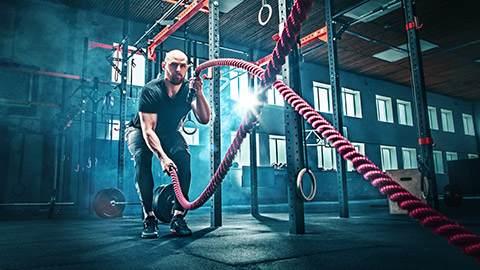
Resistance training guidelines
Resistance training is often also called strength or weight training because it involves performing physical exercises with the aid of weights(body weight or equipment-based weights) in order to improve muscular strength and endurance. It is associated with the use of weights (for example weighted bars or dumbbells) but gravity resistance bands, body weight (resistance against gravity), and some exercise machines can also be used.
Resistance training (weight training) forms a fundamental component of any exercise program. It will also form the bulk of a personal trainer’s skillset in the typical gym environment. The main components of a resistance training programme are:
- choice (exercise selection)
- frequency
- order (exercise arrangement)
- load (weight)
- volume: reps and sets
- rest periods
- variation
- progression.
When discussing resistance training, we will combine strength and power training together because most of the prescription is matched to strength training.
When a client chooses to engage in resistance training exercise, they may need advice with regards to what type of resistance training they should do and the general exercise prescription to achieve these goals. With resistance training there are three general goals a client would typically enquire about and seek your advice:
- improve muscular endurance
- gain hypertrophy or muscle size
- improve muscle strength and power.
Before we explore muscular endurance, hypertrophy, strength, and power training (and all in between) in greater detail, let's start by taking a look at some of the benefits of resistance training.
Benefits
The benefits of resistance training include:
- improved strength and muscle tone
- improved flexibility and balance
- improved weight management (either increase or decrease depending on goals)
- improved muscle to fat ratio
- greater stamina through improved muscular endurance
- decreased risk of injury
- improved prevention or control of chronic conditions (for example, diabetes, heart disease, obesity)
- improved posture
- increased bone density
- improved sporting performance
- improved self-esteem, self-confidence, and mental health.
Equipment
With the variety of resistance techniques, it is no surprise there is an almost equally wide variety of equipment to play with. Which of the following pieces of equipment are you familiar with? Are you able to competently demonstrate how to use the equipment to a client? Make an honest note of any exercises you are not completely confident in and make an effort to improve these during your studies.
 Kettlebells
Kettlebells
Resistance bands
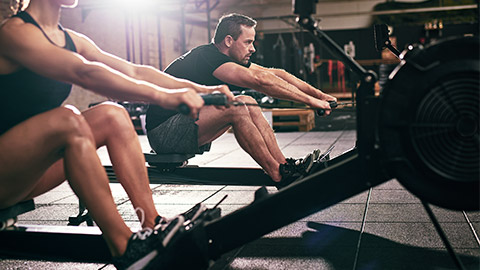
Exercise machine

Body weight

Stability
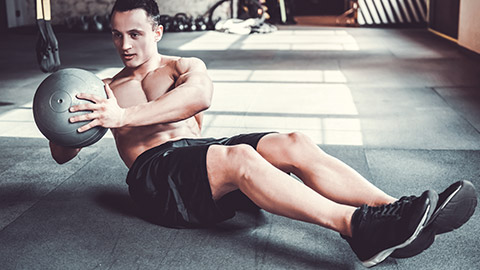
Medicine ball

Suspension training
Note that the specific programming will vary per client as this will depend on factors such as training history, body type, as well as dedication to training, the below information serves as a guide. Body type is also another factor to consider when constructing a training program and something which you may also need to explain to your client from time to time.
Our body type is genetically determined, we cannot change our body type, but we can work within its parameters with an accurate set of expectations. Typically, we all fall into one of three categories:
- Ectomorph: Long and lean muscles, has muscle definition however often finds it difficult to put on muscle mass or 'bulking' up.
- Mesomorph: Muscular, well built with defined muscle tone, high metabolism.
- Endomorph: Larger, higher body fat to muscle ratio, can tend to appear pear-shaped with a greater tendency to store fat.
Keep these in mind as you may find yourself having to explain why a marathon runner (for example) wishing to bulk up a little more, is finding it difficult to put on muscle. In short: ectomorphs will typically remain lean regardless of hours lifting weights; endomorphs find it tricky to lose the gut and mesomorphs can put on muscle mass by looking at a gym machine!
Muscular endurance looks to improve local muscle endurance of the particular muscles getting worked by having them do a high number of reps with light weights with short recovery periods; that is, longer periods of light work with rests (but short rests). This form of lifting can also improve cardiovascular fitness if enough muscle mass is worked (that is, squats vs. biceps curl). It usually forms the basis for starting any client off on their training program.
As a personal trainer, you should focus on the client's technique, work capacity, and general conditioning. Take note of the intensity, repetition range, rest between sets, and purpose of the training for muscular endurance. See the following training parameters as a guide:
- Intensity: (%1RM) = less than 65%
- Repetition range = 12-20
- Rest between sets = 30 seconds
- Set = 1-3
- Purpose of training = improve fatigue resistance.
Hypertrophy, weight training, or muscle mass training is really an advanced form of muscular endurance. It still requires a relatively high rep count, however, with relatively heavy weights now and with moderate rest periods. It is a natural progression between muscle endurance and strength training.
The main goal of hypertrophy training is to increase the muscle size which is achieved by altering the volume of training (volume = sets x reps x weight). Volume is the key factor responsible for building more muscle mass. The muscle must become fatigued for growth to occur. Take note of the intensity, repetition range, rest between sets, and purpose of the training for muscular hypertrophy.
- Intensity: (%1RM) = 65-85%
- Repetition range = 6-12
- Rest between sets = 60-90 seconds Set = 3-5
- Purpose of training = build lean muscle and tone.
Strength and power training should be done after an appropriate length of time developing muscular endurance and hypertrophy. Strength training, unlike hypertrophy, is not dependent on training volume, rather training intensity. You must work at high percentages of your 1RM to maximally stimulate your nervous system. Strength is made up of both neural (nervous system) stimulation and cross-sectional muscle size.
The only way to ‘teach’ the nervous system to recruit as many muscle fibers as possible is to ask the muscles to lift very heavy or very fast (safely!). Strength training does not develop muscle mass in the same way as hypertrophy training as demonstrated by Olympic weightlifters who are very strong vs bodybuilders who focus on muscle size.
Look at the training factors of intensity, repetition range, rest between sets, and purpose of the training for strength and power.
- Intensity: Strength = greater than 85%; Power = load depends on exercise but movement speed is a key consideration.
- Repetition range = 1-6 (strength) 6-8 (power)
- Rest between sets = 2-5 minutes (strength and power)
- Sets = 3-6
- Purpose of the training: lift heavy and fast (safely).
Let's summarise the resistance training guidelines.
| Factor | Muscular endurance | Hypertrophy | Strength | Power |
|---|---|---|---|---|
| Intensity (%1RM) | Less than 65% | 65-85% | Strength: greater than 85% | Power: load depends on exercise but movement speed is the key consideration |
| Repetition range | 12-20 | 6-12 | 1-6 (strength) | 6-8 |
| Rest between sets | 30 seconds | 60-90 seconds | 2-5 minutes | 2-5 minutes |
| Sets | 1-3 | 3-5 | 3-6 | 3-6 |
| Purpose | Improve fatigue resistance | Build lean muscle and tone | Lift heavy and fast | Lift moderately heavy and fast |

The consultation is an opportunity for a personal trainer or coach to get to know the client better and figure out their values, beliefs, exercise history, medical conditions or exercise parameters and goals. The key steps are:
- Gather information
- create rapport
- Consider exercise options with client
- Create an exercise program
- Monitor programme and client progress
- Amend programme as required.
Let’s take a look at the tools you will use when conducting a successful client consultation.
Communication skills
A very important part of your role is consulting with your client or clients. Whilst in this topic we are focusing on resistance training, you can apply the process for all clients. You will be dealing with a range of clients from across the general community, ranging from athletes to general fitness buffs, individuals with disabilities, and people from different cultural and language backgrounds.
Typically, the client consultation will be the first time you sit down with your client or potential client, so at this stage, you are quite literally strangers. In the consultation, you will be asking questions regarding health status which for many is sensitive information. Would you open up and divulge personal information to a stranger? As well as being this individual’s fitness professional, you are also creating a rapport with your client. Consider factors such as your body language, tone, posture when creating a welcoming environment for both your client and yourself. Break the ice and enjoy making a new friend.
When discussing information with your client, the best way to gather their background information is by asking a mixture of open-ended and closed questions when appropriate. You will need to:
- gather detailed medical and exercise history
- create specific and measurable goals
- determine any weaknesses/barriers to exercises.
Examples of open-ended and closed questions a personal trainer could ask are shown in the following table.
| Open-ended questions | Closed questions |
|---|---|
|
What objectives do you have? Tell me about your experience of visiting a gym? What are your expectations for a program designed to increase strength? What type of exercise activities do you enjoy? What are your top three goals? |
Is increasing your muscles your key objective? Have you ever attended a gym before? Do you have any physical conditions that affect you using weights or other equipment? Have you ever used a rowing machine? |
Consider when each of these question styles would be most appropriate and effective when seeking to gather the information you require.
Documentation
You will be required by your gym to complete documentation recording the consultation. These are typically called screening forms. However, you may also hear other terms for this such as pre-exercise screening form and similar. Each gym will have its own paperwork and processes for recording and filing the records. Confidentiality and client privacy is essential and legally required, therefore make sure any completed paperwork is stored safely and securely.
The NZ Register of Exercise Professionals (REPs) which is recognised by the industry association Exercise New Zealand, has created and published a comprehensive version of a Pre Exercise Screening Form. Look at the REPS Pre-screening form and the information captured in each section. Consider how you would frame your questions when completing this with your client. Note, each fitness facility may have slight variations of this form with minor differences in the questions, mostly in the layout.
Look at the REPS Pre-screening form which is approved by the New Zealand Register of Exercise Professionals. You can see it has the following sections:
- Important medical information
- A diagram to label areas of the body that may be adversely affected by exercise, for example, any sites that have had an injury (even in childhood) and any areas which currently have a complaint
- Programming information including exercise goals, exercise history, client availability
- Monitoring progression
- Measurement recording
- Proposed schedule.
You may wish to download this document for future reference.
Note: Everyone is different, not everyone is comfortable discussing their medical history or realises the importance of discussing an incident or surgical procedure they had as a child or a young adult. This is where you as the fitness professional use your open-ended questions to establish where further information is required. In addition, use your body language, tone, and verbal delivery to ensure the client feels comfortable sharing what essentially is personal information. You may need to gently explain to the client that an injury that occurred 10 years ago when they were younger is still relevant to a training program today.
Watch the following video to learn more about conducting a fitness consultation for a new client.
Practice completing a consultation or pre-exercise screening tool – you can use the REPs form provided here or one from a local gym. Ask a colleague or friend to role-play a new client or speak into a mirror. Were there any terms or instructions on the REPs form you did not understand? Always check with your manager if you are unsure of anything. It is important to be comfortable navigating your clients through this form, the more natural and less scripted you can be will aid in creating both report and comfort to your client when sharing personal information, you also need to be comfortable in order to ensure you use the correct terminology when framing or re-framing questions in order to ensure you have all the relevant information you require in order to create a safe and effective training program.

The information you gather in the consultation will help you prepare a program for your client. The form you use to document the programme will vary slightly depending on your workplace but will include sections for documenting weekly dates, goals, strength, and cardio training as well as warm up and cool down instructions.
All gyms will require you to consider and document the following information:
- choice (exercise selection)
- frequency
- order (exercise arrangement)
- load (weight)
- volume (reps and sets)
- rest periods
- variation.
Let us look at these in more detail.
Choice
The personal trainer should select exercises based on:
- client experience (exercise history and level) which equals training age
- the specificity principle
- client needs, wants, and preferences
- client availability
- equipment availability
- ability and willingness of the client to perform exercise correctly
- ability of the client to conduct program outside supervision by the personal trainer.
Remember, the specificity principle means you should target the training.
Frequency
Below is a rough guide of the different training statuses of clients. These can vary slightly from individual to individual; however, the general rule of thumb is frequency will depend on the resistance training status of the individual:
A client new to exercising or with less than six months of consistent resistance training experience.
Has been training consistently and regularly for six months or more.
Easier classified not on time as per the others but on their skill and technique development. This usually takes years. Typically, advanced clients will have already mastered the techniques to near perfection.
The following table provides general guidelines for resistance changing frequency.
| Resistance training status | Recommended session per week |
|---|---|
| New or beginner | 2-3 |
| Intermediate | 3 if using total body training or 4 if using a split routine |
| Advanced | 4-6* |
* Advanced resistance trainers may perform multiple sessions in one day.
Easier classified not on time as per the others but on their skill and technique development. This usually takes years. Typically, advanced clients will have already mastered the techniques to near perfection.
- Beginner: Some new to training/exercising. Someone who has not consistently trained regularly and/or achieved results for six months or more. Someone who is new to an exercise type, for example, bodybuilder wishing to focus on their cardio (chances are this is a new training focus for them).
- Intermediate: Has been training consistently and regularly for six months or more. They have built up basic strength, skill in their program, and also borderline mastered their technique in these.
- Advanced: Easier classified not on time as per the others but on their skill and technique development. This usually takes years. Typically, advanced clients will have already mastered the techniques to near perfection, clearly understand the rationale behind their program and technique, and are very close to, if not already, achieving their maximum natural potential. This category typically sees the least amount of people.
When designing a program and instructing your client, it is hugely important to be realistic about training status, this is not a space where ego belongs. One rationale behind this and a hugely important one is safety considerations. Here this does not refer to simply the safety desired during the training session, but this is after the training session and for years to come. As a fitness instructor, the aim is to positively enhance an individual’s life, for the 30-60-minute session but also for the rest of their life. Some of this we do not have control over however if we implement due diligence and duty of care, we can know we have done the very best for our client.
Let us put this into context a little. The rationale behind the safety aspect of exercise selection is to ensure an injury is not caused by our selections/ advice. In order to achieve this, we consider aspects such as motor patterns and giving the brain enough time to understand these messages we are giving them (by asking our bodies to do these weird things in the gym) and giving the muscles time to be strong and proficient at performing these. Like anything in life really, we take time to learn the basics of a new skill, then we build on this and add complexities as we become competent, it’s the same in gym training. So, when working with a “beginner” we tend to, after discussing their training and medical history, begin on machines and review technique and skill level. the client could be on machines for some exercises longer than others as their skill development grows for different activities at different rates, that is ok. What is important is that they are advanced when ready, in order to give them the best success in achieving goals in their program as well as ensuring their safety.
Order
Exercise order helps you prioritise exercises that require more muscular (and neurological) demand, coordination, strength, or power or speed and technique than others. It is advised to place the more physiologically demanding exercises at the beginning of the program/session when the client is fresh rather than towards the end when the client is tired, weak, and at greater risk of mistake and injury. For example, a barbell squat should be performed before a calf raise.
Physiologically, the movement, coordination, activation of muscles and neurological pathway required in this type of exercise is more demanding and requires more of the body as a whole than a smaller, less demanding exercise such as calf raise. If the client did the calf raises first, became fatigued, then tried to do their barbell squats (with the calf fatigued) correct and safe movement pattern would be at risk. This would increase the potential of injury as well as fewer gains being achieved during the squat. For example, power production would decrease, and typically the speed of movement would diminish.
The following tips from the National Strength and Conditioning Association (NSCA) will help you devise a program:
- Focus on large muscles before smaller ones.
- Focus on complex muscles before simpler ones.
- Focus on multi-joint exercises before single-joint exercises for strength training.
- Work on total-body lifts before basic strength and single-joint for power training.
- Move from high-intensity to lower-intensity for exercises stressing similar muscle groups.
- Rotate agonist-antagonist (opposing muscles) exercises
- Rotate upper and lower body exercises.
Now would be a good time pause, look back at what you have just covered and note down any new or unfamiliar terms and add these to your terminology and vocabulary reference guide.
Exercise selection
What is the big rocks theory? This theory of exercise selection is an analogy for the following question: If you had a pile of rocks, stones, and sand and a large container and were asked 'What is the quickest and most effective way to fill the container with the ingredients you have leaving no spaces in the container?'
The obvious answer would be to put as many big rocks as possible in the container first, then fill in the gaps with the smaller stones and then finally pour in the sand to fill in any remaining gaps! This applies to exercise selection too.
When looking for resistance training gains, the big compound exercises (such as squats, deadlifts, and bench) are your rocks. You then add your stones (machine weights, assistive exercises) to fill in some of the gaps. Finally, you pour in the sand to fill the remaining gaps (for example, stretching, resistance band work, and swissball work).
Following this order will ultimately give you the best results in the shortest amount of time.

Load (weight)
The training load or amount of weight used in a resistance training program is one of the most important factors to consider when you are designing a programme for a client. The training load will affect the number of repetitions that can be performed by the client and the physiological adaptations.
Below is a chart showing the estimated number of repetitions a client will be able to complete with a certain load or %1RM. This chart tends to hold true for most people and should be considered when programming. For example, you can see that normally a client can typically complete six reps at 85% 1RM, therefore, it would be incorrect to program 10 reps at 85% 1RM as this would not be possible and put the client at risk.
| %1RM load | Estimated number of reps |
|---|---|
| 100 | 1 |
| 95 | 2 |
| 93 | 3 |
| 90 | 4 |
| 87 | 5 |
| 85 | 6 |
| 83 | 7 |
| 80 | 8 |
| 77 | 9 |
| 75 | 10 |
| 70 | 11 |
| 67 | 12 |
| 65 | 15 |
| 60 | 20 |
How do you assign a load?
Training load is assigned as a percentage of a repetition maximum (or % 1RM), which is the maximal load a client can handle in a specific exercise for a specific number of repetitions.
Rather than using a %1RM to describe load, you could use a repetition maximum (RM) load target. Many clients will find this terminology often easier to understand than a %1RM. It is easy for people to understand lifting a max weight for a certain number of repetitions. As a rule of thumb, hypertrophy and muscular endurance programs aim to have high volumes whereas strength and power programs have lower volumes. This method uses the heaviest load a client can manage for a certain number of repetitions. That is, a 12RM load is the most weight a client could lift for 12 reps. Looking at the chart above, this would correspond with about 67% 1RM.
Let's look at an example. Imagine you have tested a client's 1RM load to be 85kg in the bench press. You program a workout that includes three sets of eight reps @77% of 1RM. What is this load in kgs? The NCSA assigning load and reps based on the training goal are shown in the following table.
| Type | %1RM | Reps | Rest time |
|---|---|---|---|
| Endurance | < or equal to 67% | > or equal to 12 reps | < or equal to 30 seconds |
| Hypertrophy | 67-85% | 6-12 reps | 30-90 seconds |
| Strength | > or equal to 85% | > or equal to 6 reps | 2-5 minutes |
Volume
Training volume represents the total amount of work done in an exercise, workout, or training block. It is simply calculated in the following way:
- Volume = sets x reps x load
For example, if a client did three sets of 15 reps at 80kg their total volume would be:
- Volume = 3 x 15 x 80kg = 3,600
This is a very useful figure as it represents a workload across an entire exercise, workout or training block. Look at the lower body workout* example below which has volume calculated across each exercise and for the entire workout. This number, 11,090 could be used to progressively overload the volume component of exercise prescription across the training cycle.
| Exercise | Sets | Reps | Load | Volume |
|---|---|---|---|---|
| Squats | 4 | 10 | 110kg | 4400 |
| Lunges | 2 | 12 | 85kg | 2040 |
| Leg press | 2 | 8 | 150kg | 2400 |
| Leg curls | 3 | 15 | 50kg | 2250 |
| Total volume | 11090 |
* This is a simple example of a split routine, lower body and upper body split. Volume is a key determinate of fatigue therefore it is best to compare like with like. Separate the upper and lower body muscles in particular so you can determine the total workload on these major muscle groups.
Rest periods
| Training goal | Rest period |
|---|---|
| Strength | 2-5 minutes |
| Power | 2-5 minutes |
| Hypertrophy | 30 seconds to 1.5 minutes |
| Endurance | < or equal to 30 seconds |
Do you remember what hypertrophy means? In simple terms, it refers to an increase in the size and definition of a person’s muscles achieved through exercise. Lifting weights is the most common way to do this. Rest periods are important in hypertrophy as a shorter rest period keeps the blood in the working muscle which brings nutrients, hormones and oxygen which can increase muscle growth.
Variations
Regardless of how effective or individualised a training program is, it will eventually need to be varied to ensure continued adaption and to keep a client motivated and engaged! A variation involves alternating training variables to produce adaptations over the long term. Less variation is needed with novice or untrained clients, as any reasonable training plan will produce results. As clients become better conditioned, their progress may begin to slow if the programme does not include variation and progression.
Common variations include planks, squats, and push-ups. We'll look at these in more detail shortly. First, let's put into practice what has been learned so far.
Variation
Variation of a training plan can occur within a workout, during the week, or over several weeks. Why is variation important? There are a number of reasons:
- To motivate the client and prevent boredom
- To target specific muscles
- To challenge your client and see improvements in fitness levels!
- To work on different training goals (i.e. strength, muscular endurance, hypertrophy)
Let us look at variations in common exercises including planks, squats, and push-ups.
Planks
Planks are likely to be in most fitness programmes. Have a look at the image below. Are there any variations you can add to this list?
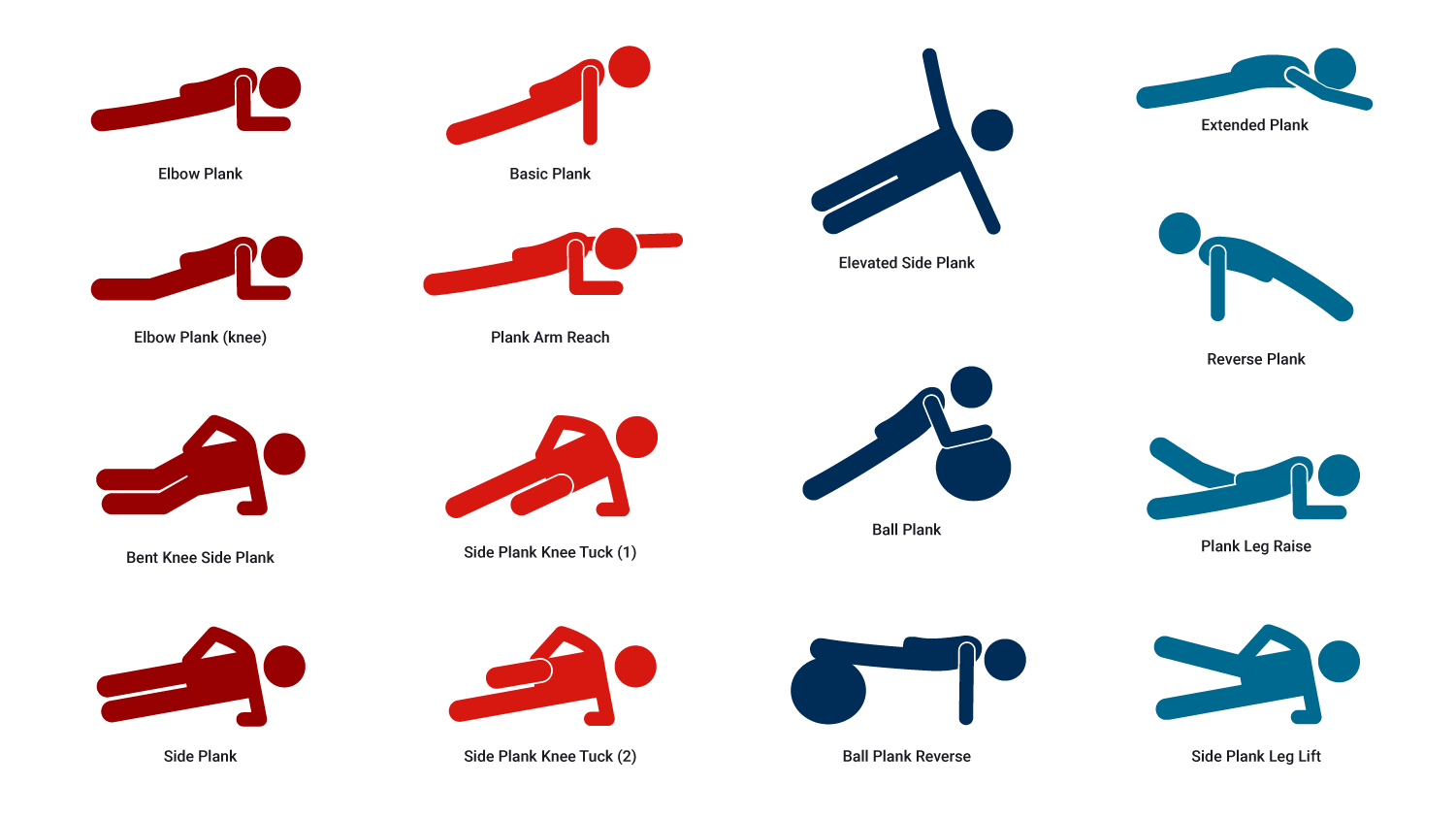
Squats
A squat is a strength exercise in which the client lowers their hips from a standing position and then stands back up. During the descent of a squat, the hip and knee joints flex while the ankle joint dorsiflexes. At the same time the hip and knee joints extend and the ankle joint plantarflexes when standing up.
The following video demonstrates over twenty squat options.
Push-ups
Push-ups are a fast and effective way to build upper body strength and work the triceps, pectoral muscles, and shoulders. They can also strengthen the lower back and core by engaging (pulling in) the abdominal muscles. Push-ups are one exercise in which there is lots of variety so your client should never get too bored!
Watch the video below for over thirty variations. Have you seen any other variations in your gym (or elsewhere)? What exercises would challenge you or a client?
What is progression and maintenance?
An essential component of any training program is progression and maintenance. What is the difference? What do you do when you have accomplished something? Take on the next level! We humans do not like to be bored, neither do we stick with the same exercise program. Once our bodies have accomplished a skill, we either need to keep doing it to keep us 'fresh' or step it up and learn new aspects of the skill. The same is required from an effective training program (and to keep clients). Let us start by looking at the difference between the two.
Progression is the process in which the client continues to move towards a predetermined goal.
Maintenance is when the goal has been achieved and the client is attempting to maintain a specific level of fitness.
Progression and maintenance can be achieved through increasing loads, volume or frequency or making alternations that modify the training stimulus. Different training loads have different effects on the client’s recovery.
Study the graph below and see what this means in terms of whether the training is too easy, adequate, or too hard. Note where overcompensation is also occurring. You will see there is an optimal threshold from maximal supercompensation following a training program. Keep this graph in mind when designing a program for clients in the progression or maintenance stage and vary the factors you are learning about to create an effective and relevant program.
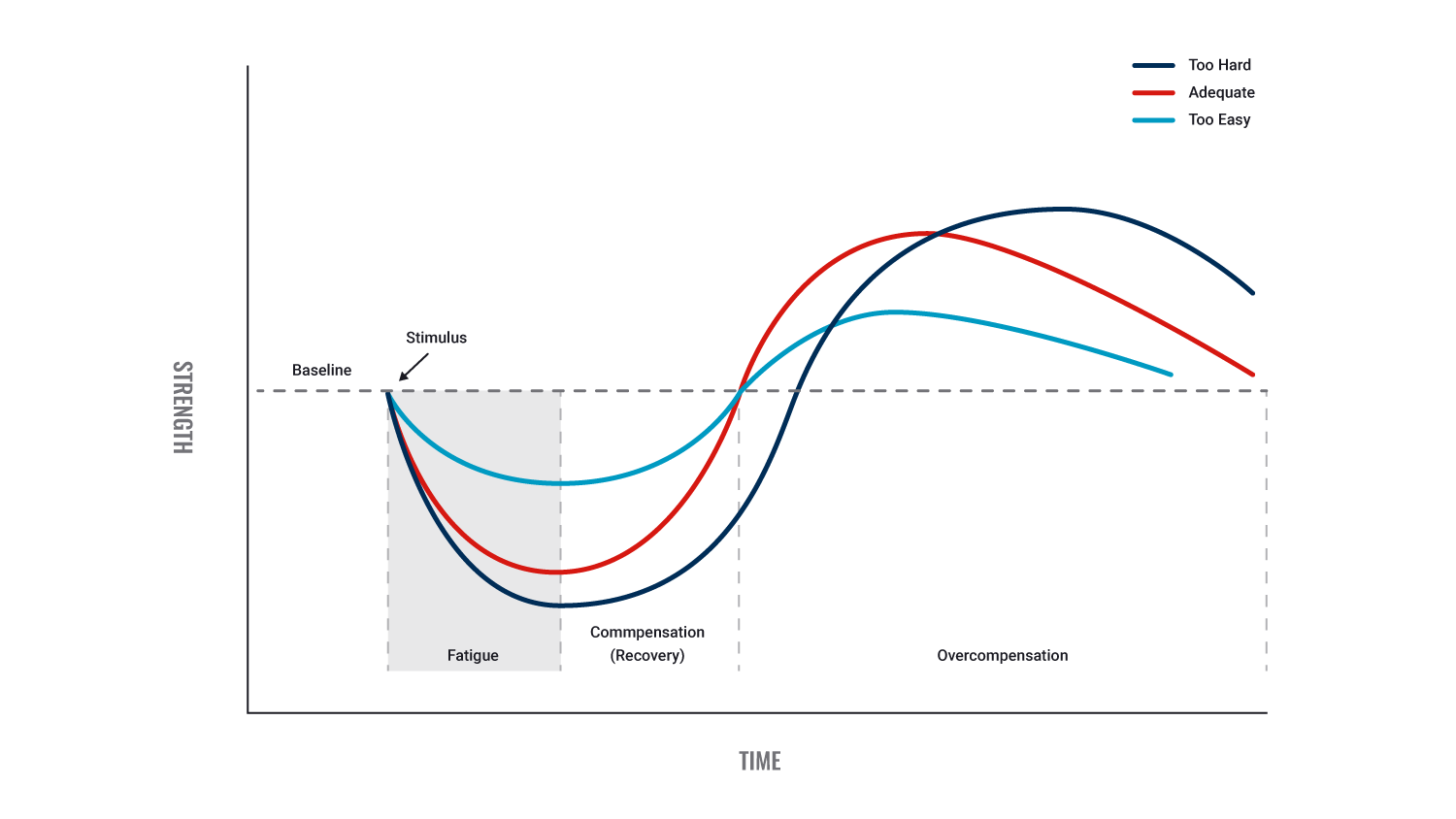
Remember, supercompensation or overcopensation is just a fancy word for increased fitness adaptation. Anything that enhances supercompensation will improve long term training progression.
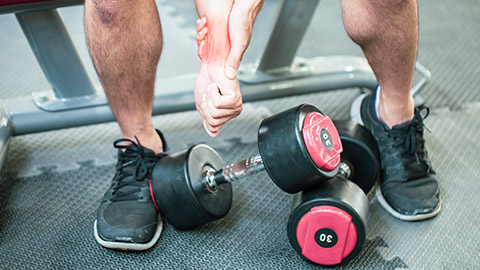
Ensuring your personal safety as well as the safety of your colleagues, clients and any other visitors to the gym (or any location where you are working) is non-negotiable. A zero-tolerance for unsafe practices will ensure the risk of injury is controlled. Industry bodies ensure a code of ethics and practice is adhered to.
Common causes of injury include:
- incorrect technique and poor training
- too much weight
- bad spotting
- incorrect use of cheating and forced reps
- training too often
- not stretching and inadequate warm-up
- lack of concentration
- too much 'bro science'
- excessive pre-workout.
Let us look at the consequences of each.
Too much weight
As a rule of thumb, never increase lower body exercises by more than 10% and upper body exercises by more than 5%.
Too much weight and muscles can start to break down making them prone to injury. The first warning signs are symptoms similar to the classic overtraining syndrome that endurance athletes experience including soreness and fatigue. As soon as a client starts to lift too much weight you will quickly see their technique fall apart.
As a trainer, always prioritise technique and form overload. This is where a good trainer comes into their own with great cues to help people perfect their form and lift appropriate amounts of weight.
For beginners, always start with lighter weight and aim for more reps over the initial weeks. Once their form becomes engrained and they have developed a base of muscular endurance you can slowly start to increase weight.
Bad spotting
Spotting means supporting another person during an exercise, with an emphasis on allowing the client to lift or push more than they could normally do but push more safely. A spotter's primary role is to assist an exercise to help protect the client from injury. A spotter may also provide additional motivation to the client to help the client develop confidence and improve their techniques and achieve the additional weight or additional repetitions. This is usually only done with free weight exercises including:
- bench press
- barbell back squat
- military press
- skill crusher
- upright row
- dumbbell bench press
- dumbbell flies
- dumbbell shoulder.
Your gym may have specific requirement for spotting. For example, exercises you should not spot because it can be dangerous to the client and you as the personal trainer. You will need to check this with your manager. These may include:
- deadlifts
- crunches
- hyperextensions
- high pulls
- push press.
Whilst the following video from BBC 4 of the worst gym spotters is light-hearted, the message is not. You will see bad spotting practices including T-bagging (being too close), texting, being too technical, and being far too sweaty!
The following image shows a personal trainer spotting a client with his hands ready to assist if required. Note the position of the spotter behind the bench which allows an appropriate distance from the client.

Incorrect use of cheating and forced reps
In simple terms, cheat reps are overloading the muscles you’re intending to train and getting other muscles involved to lift more weights. In other words, any exercise in which momentum or additional muscles are used to complete the exercise. For example, whipping legs back and forth when performing a chin-up ( dolphin kicking) or swinging the hips and using the legs to assist in dumbbell curls to name a few. Cheat reps enable the client to utilise additional volume and push the muscles past the point of failure. Cheat reps are as they sound on the tin, they come at a cost, a risky cost- injury!
Cheat reps can be and are incorporated into programs that, if done with an understanding of the science and rationale behind them can be safely incorporated. A solid rule of thumb would be 90-95% of each set should be performed to perfection before considering a cheat rep for the last rep as a finishing touch to the set. The need for cheat reps for your client's program will be best determined by their goals and is generally thought of as more of a strength and power style of training.
Forced reps require a spotter and are done after the client has run out of steam towards the end of a set. At that point, the spotter will lift an increasing percentage of each remaining rep which allows the client to complete the set. If you have ever experienced fatigue at the end of a set, you will know that a cheerleader at this stage is a hugely appreciated support. A spotter would also be a source of motivation for the client (or exercise partner) to help get them across the line and complete their set.
The biggest mistake is when the client does not make the spotter aware of what is happening. Forced reps also put the muscle in a very fatigued position which automatically increases injury risk substantially. Communication is key. Encourage your client to talk to you during their sets and let you know of their intentions and capabilities.
Training too often
Training at too high of intensity or duration too often can result in overtraining, which can trigger adverse side effects that indicate your client is working too hard. While this may not happen immediately, if the client is training too often with insufficient rest the body will suffer fatigue. In addition, techniques will be adversely affected, gains will be limited, and ultimately the body may shut down which results in a greater time of training than a rest day or two would have taken. The human body does not adequately adapt to training in a state of constant fatigue. One of the most important skills for a trainer to master is training volumes and recovery periods.
Not stretching
When the muscles are activated, they contract and produce movement for a variety of purposes from escaping from dangerous situations to general exercise and movement. When resistance is added (either resistance offered by gravity or by adding additional weights) this increases the tension created during each muscular contraction and often sees a shortening of the muscles.
Not stretching results in muscle tightness and therefore, a decrease in performance. It can also:
- increase the risk of injury
- cause muscle degeneration and poor circulation such as tingling, numbness as well as pain and muscle cramps.
When stretching, the aim is to remove the tension in the ligaments and tendons around the joints as well as in the muscles themselves along with sending oxygen and other vital nutrients in the blood to the muscles. Advise your client to stretch to the point of tension but not to the point of pain, hold stretches for 15-30 seconds, and use a variety of stretching techniques when the muscle is warm.
A key pointer when stretching: breathe! It sounds obvious but 99% of people forget to breathe and end up holding their breath during a stretch. This may be because they are so busy focusing on the technique and the sensation of tension versus pain that breathing tends to pop out the mind.
Inadequate warm-up
Warm-ups increase heart rate and blood flow to the muscles which help prepare the body for exercise. If a client does not warm-up, they may experience muscle cramps, injury, decreased performance and can fatigue prematurely.
Lack of concentration
Lack of concentration may lead to serious accidents or events. Paying attention to how a client is performing an exercise, their level of exertion, and physical responses to the exercises (for example, gasping for air or being shaky) is an important duty of care personal trainers have to their clients. As a trainer, it is important that all your attention and focus is on your client. Any text messages or socialising with others can wait until the client, who is paying for your services has finished their session.

Too much 'bro science'!
'Bro science' is a term for misinformation circulated among men (predominantly) in a gym and usually centres around bodybuilding claims that are not backed by science. For example, it may include diet trends or the notion that a fitness program does not require cardio. Be wary as to what you hear, do your research, and use your own knowledge to determine the reliability of the information you hear in the gym or fitness environment.
Excessive pre-workout
Pre-workout supplements before exercising are becoming increasingly popular before exercise. If it is being incorporated into a training regimen, it is recommended around 20-30 minutes before the workout. For clients who prefer to work out in the evenings, be careful how late the client consumes the pre-workout. If the client is planning on taking it a few hours before getting some shuteye, then suggest the client reconsiders. The pre work out supplements may provide an energy boost; however, they can cause side effects including vomiting, jitters, cramps, high blood pressure, and in rare cases, cardiac arrest. Unless they are happy to be awake longer due to the caffeine and other stimulants incorporated in the pre-workout.
You have covered a lot of information, and there is a fair bit of science behind exercise programming with each variable serving its own importance. Take your time to review each of these in isolation and how they function as a collective. Each one of these essentially embeds your expertise as a fitness professional and also forms the foundation of your duty of care. Become comfortable with these and share this knowledge with your clients. For some light relief, enjoy this short video of people who have not had the benefit of professional advice.
In this topic, we focused on resistance training fundamentals. You learnt about:
- resistance training guidelines
- body type
- muscular endurance
- muscular hypertrophy
- strength and power training
- client consultation
- documenting a programme
- variations
- safety considerations.

